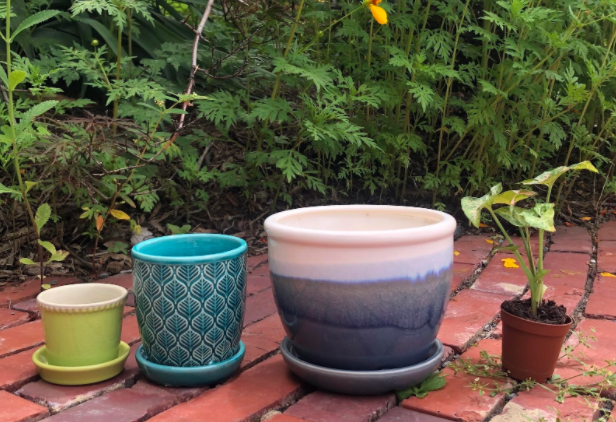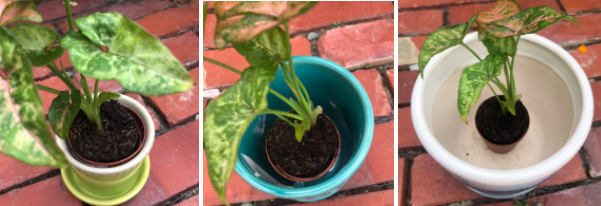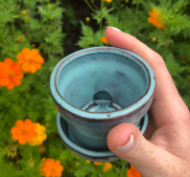
-Ginny Shafer-
You finally did it! You assessed the lighting conditions in your home, had an honest conversation with yourself about how often you’ll *actually* water your plants, and you’ve found your perfect houseplant! Now to find the perfect pot to show it off. Just like with lighting and soil, every plant has different needs with respect to planting, so it’s important to choose a pot that’s well suited to meet those needs.
When Should I Repot?
Houseplants can be repotted when they’ve outgrown the container they’re already in. Check to see if roots are growing out of the bottom of the pot, or if the plant stops showing new growth in the spring and summer. These are signs that the roots are wrapped around themselves too tightly to get enough moisture and nutrients to the plant, and that they need more room.
Most houseplants can be repotted once a year, but there are a few that like to be root bound in their containers, including succulents, cacti, bromeliads, and sansevierias. These don’t need to be repotted as often. Regardless of how often you repot your houseplants, it’s always a good idea to do it in the spring so they’ll have plenty of time to grow into their new home!
Outgrowing its container is the most common reason to repot your houseplant, but it’s not the only one! You may need to repot if your plant needs fresh soil, or if the soil has been infested with mealybugs or ants.
Size

One of the most common repotting questions I get is, “Is this pot the right size?” Usually, my answer is, it depends! If you’re repotting your plant because you want to give your plant room to grow, you’ll want to get a pot 30% larger than the one it’s currently in (blue pot in photo). However, if you’re happy with how big your houseplant is, or if it’s grown to its full size, you can stick with the same size pot (green pot in photo).
It’s also important not to get a pot that’s too big for your plant (white pot in photo). Potting soil holds on to excess water, and the more soil that’s in the pot, the more water it will hold on to. While moisture-loving plants like calatheas may not mind, plants that are susceptible to root rot will suffer.
Drainage

Whenever I’m looking to plant in a new pot, I always look for one that has at least one drainage hole. It allows extra water to escape, which prevents the soil from becoming waterlogged. This is why drainage holes are especially crucial for plants that don’t need a lot of water, like succulents and ponytail palms. Drainage holes also help reduce salt buildup in the soil, since water flowing out of the hole will take the extra salt with it. Since most plants don’t like soggy, salty soil, I think it’s always a good idea to plant in pot that has at least one drainage hole.
Some pots with a drainage hole have an attached saucer, others have a separate saucer. Either way, overzealous waterers like me should consider getting a cork plant mat to put underneath the saucer to protect furniture and other surfaces.
If you have your heart set on planting in a pot that doesn’t have a drainage hole, you can put a layer of hydroton at the bottom of the pot and only water your plant lightly. If you’re concerned about overwatering your plant, you can use a Blumat waterer as a low maintenance, set-it-and-forget-it solution!
The many cachepots (pots without drainage holes) you see for plants are generally used not as planters, but as decorative containers that plants in plastic nursery pots are simply set into. You may want to put a layer of hydroton in the bottom of your cachepot and place the potted plant on top of it so it is raised above the water that will drain out of the plastic pot into the bottom of the cachepot.
Material
Another thing to consider is what material you want your pot to be made of. At Fifth Season, we have a wide selection of pots made of plastic, ceramics, and fabric. Plastic pots are lightweight, colorful, and inexpensive, but could cause roots to overheat if they’re put in a sunny spot. Ceramic pots, including terra cotta, can help absorb excess water and keep the roots cool. They also come in a wide range of styles to complement your home decor. Fabric pots allow the roots to breathe and have excellent drainage. If you choose a fabric pot for your indoor houseplant, you may want to put a plastic tray underneath it to protect your floors or counters.
Choosing the right pot can be tricky, but doing a little bit of research on your plant’s needs can help narrow down your options and ensure that your houseplant stays happy and healthy! We are happy to talk with you about the repotting process, and If you want to make sure everything is perfect, we can even pot your plant for you. Good luck, and happy gardening!

Mason Smith says
It’s so great that you touched on how houseplants can be safely repotted after they outgrow their current pot. My brother is trying to get into gardening this year so that he can grow some of his food. He needs to find the right pots and saucers so that he is successful as a gardener.
Ivy Boydstun says
Your picture guide in this article is extremely helpful, more so than just how many inches larger the pot should be! Thank you very much.
ashley says
So glad you found the post helpful, Ivy!
Rebecca says
I have a swiss cheese plant that was bought from a supermarket last year. The pot size is 7×5″. I want to repot it and all the information I’ve read says to go up 2″, but I am wondering whether I should go larger (3″) as when I got it, it already had a couple of roots coming out of the top. Any advice would be much appreciated.
ashley says
Hi Rebecca,
Swiss cheese plants, being Philodendrons, climb up trees in the wild. Having roots coming out of the pot is natural and healthy for the plant. You don’t necessarily need to cover all the roots. If you go too much bigger, that is more soil in the pot that will be holding moisture, and you may run the risk of too much moisture causing root rot.
Philodendrons like to be a little snug in the pot. I would say that going up 2 inches bigger would be good.
When you water it be sure to water thoroughly so the center of the root ball gets hydrated, then let it get dry before watering.–Pam at Fifth Season Gardening